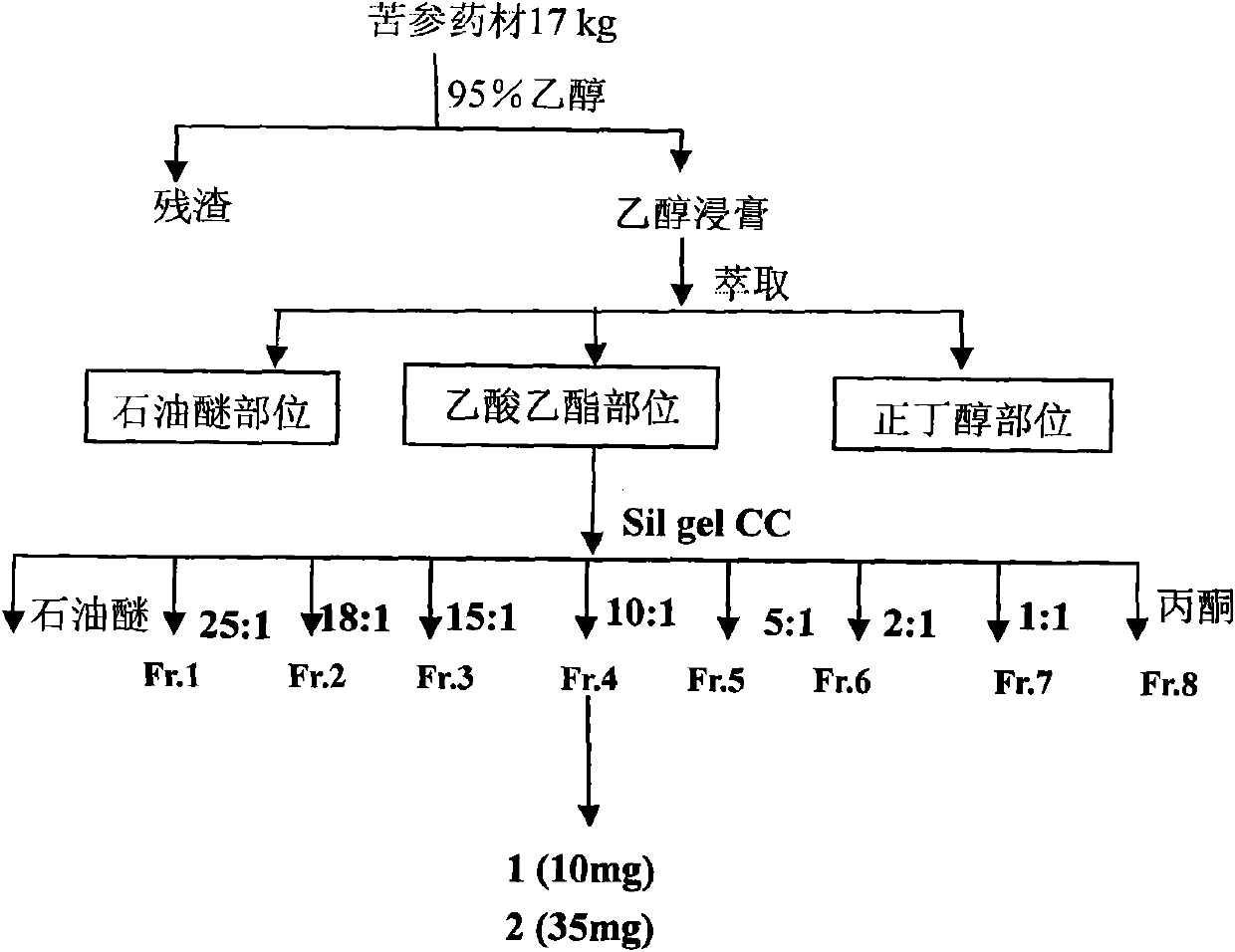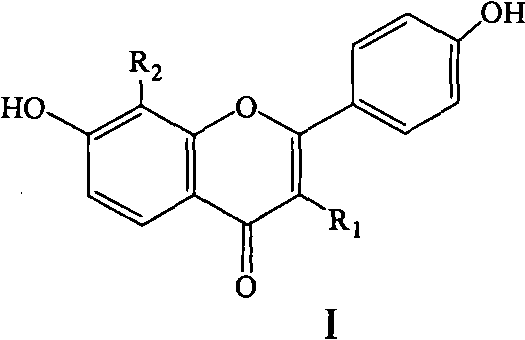Application of flavonoids compounds in preparation of anticomplement medicaments
A technology of flavonoids and anti-complement, which is applied in the directions of pharmaceutical combinations, pharmaceutical formulations, medical preparations containing active ingredients, etc.
- Summary
- Abstract
- Description
- Claims
- Application Information
AI Technical Summary
Problems solved by technology
Method used
Image
Examples
Embodiment 1
[0021] The preparation of embodiment 1 flavonoids
[0022] Take 17 kg of dried roots of Sophora flavescens, repeatedly cold soak and percolate extraction with 95% ethanol at room temperature for several times, and concentrate the extract under reduced pressure to obtain 2.7 kg of extract. Take 1.2kg of extract, suspend in distilled water, extract with petroleum ether, ethyl acetate and n-butanol successively, and concentrate to dryness respectively, among which 460g of ethyl acetate extract. Take 160g of the extract from the ethyl acetate fraction, perform silica gel column chromatography (column specification: 11x85cm, silica gel: 200-300 mesh, 1.8kg), elute with petroleum ether-acetone gradient, and then perform silica gel column chromatography with different eluents. And Sephadex LH-20 column chromatography, concrete steps are as follows:
[0023] The fractions eluted with petroleum ether-acetone (10:1) were subjected to silica gel column chromatography with petroleum ethe...
Embodiment 2
[0024] Example 2 Anti-complement classical pathway test in vitro
[0025] Take 0.04mL of complement (guinea pig serum), add 0.36mL of BBS to prepare a 1:10 solution, and double-dilute with BBS to 1:20, 1:40, 1:80, 1:160, 1:320 and 1:640 solution. Dissolve 0.1 mL each of 1:1000 hemolysin, 2% SRBC, and 0.2 mL of each concentration of complement in 0.2 mL BBS, mix well, put in a low-temperature high-speed centrifuge at 37 °C for 30 min, and centrifuge at 4000 rpm and 4 °C for 5 min . Take 0.2 mL of the supernatant from each tube and place it in a 96-well plate, and measure the absorbance at 405 nm. A full hemolysis group (0.1 mL 2% SRBC dissolved in 0.5 mL triple distilled water) was also set up in the experiment. The absorbance of three-distilled water lysed blood vessels was used as the standard of total hemolysis, and the hemolysis rate was calculated. Taking the dilution of complement as the X-axis, the percentage of hemolysis caused by each dilution of complement is plot...
Embodiment 3
[0026] Example 3 Anti-complement alternative pathway test in vitro
[0027]Take 0.06mL of complement (human serum), add 0.24mL of AP diluent to prepare a 1:5 dilution solution, and double-dilute to 1:10, 1:20, 1:40, 1:80, 1:160, 1 :320 and 1:640 solutions. Take 0.15mL of each concentration of complement, 0.15mL of AP diluent and 0.20mL of 0.5% RE, mix them evenly, place them in a low-temperature high-speed centrifuge after 30 minutes in a 37°C water bath, and centrifuge at 4000rpm and 4°C for 5 minutes. Take 0.2 mL of the supernatant from each tube and place it in a 96-well plate, and measure the absorbance at 405 nm. A complete hemolysis group (0.20 mL of 0.5% RE dissolved in 0.3 mL of triple distilled water) was also set up in the experiment. The absorbance of three-distilled water lysed blood vessels was used as the standard of total hemolysis, and the hemolysis rate was calculated. Taking the dilution of complement as the X-axis, the percentage of hemolysis caused by ea...
PUM
 Login to View More
Login to View More Abstract
Description
Claims
Application Information
 Login to View More
Login to View More - R&D
- Intellectual Property
- Life Sciences
- Materials
- Tech Scout
- Unparalleled Data Quality
- Higher Quality Content
- 60% Fewer Hallucinations
Browse by: Latest US Patents, China's latest patents, Technical Efficacy Thesaurus, Application Domain, Technology Topic, Popular Technical Reports.
© 2025 PatSnap. All rights reserved.Legal|Privacy policy|Modern Slavery Act Transparency Statement|Sitemap|About US| Contact US: help@patsnap.com



